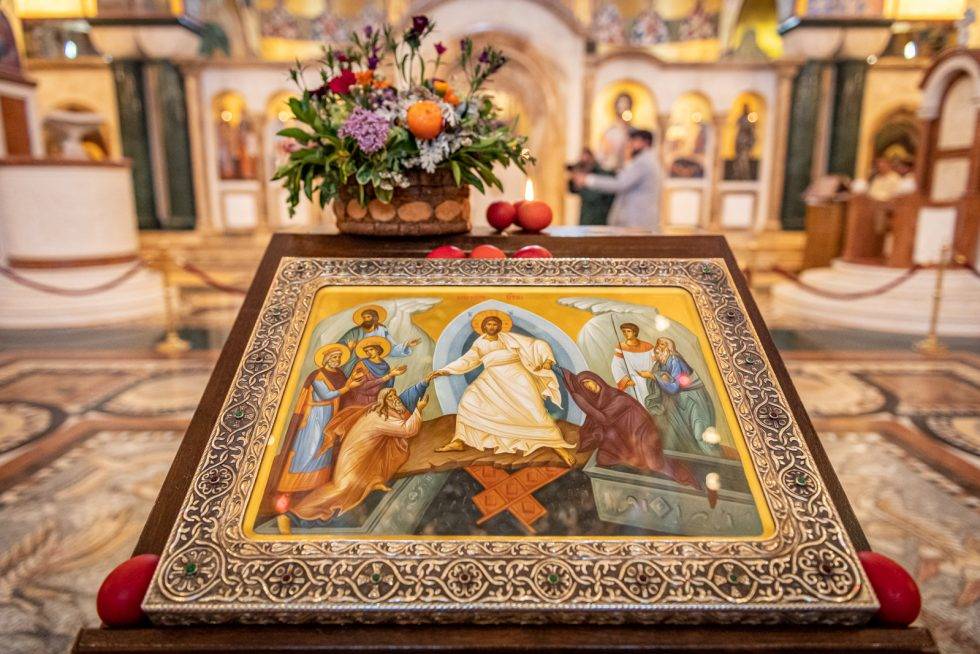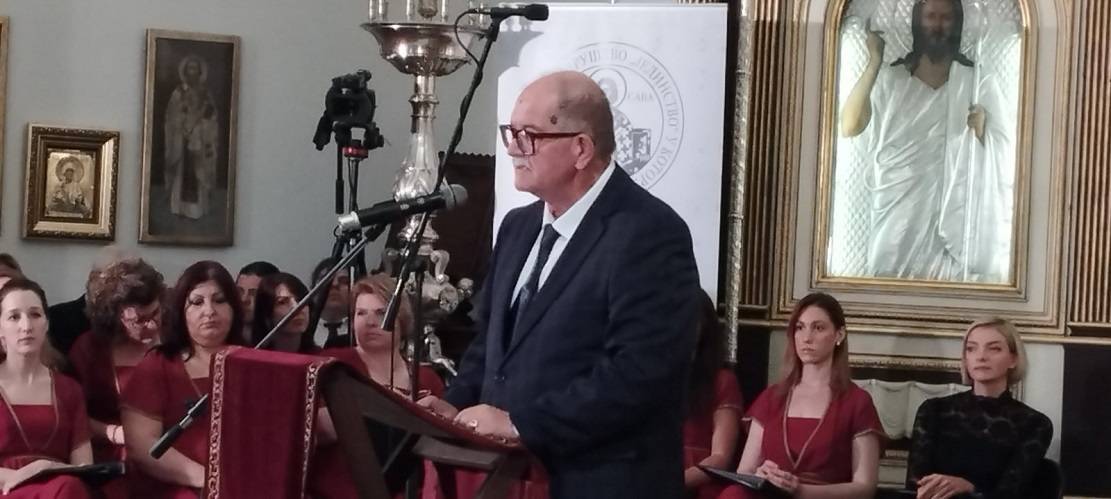
PROF. DR TANASKOVIĆ: THE JEDINSTVO ALIVE THE METAPHOR OF SAINT SAVA'S SERBIAN VIRTUES
Prof. Dr. Darko Tanasković said that the Serbian Singing Society (SPD) "Jedinstvo" (1839) Kotor is a living metaphor of Serbian virtues of Sveti Sava.
Prof. Dr. Tanasković spoke yesterday at the Ceremonial Academy on the occasion of 185 years of work and existence of the Serbian Singing Society "Jedinstvo" (1839) Kotor, with the presence and blessing of His Holiness the Patriarch of Serbia, Mr. Porphyry, His Eminence Metropolitan Ioanniki of Montenegro and the Littoral, faithful people and numerous guests from public and political life.
"He who sings evil does not think, our people say. Blessed is the happy and indestructible people who keep their faith in stone and in song despite all the adversities.
Nowhere is this so clearly and elementally united, connected and expressed as in the Serbian Boka of Svetosavska and in general on our Primorje.
Saint Bishop Nikolaj Velimirović, as a young man of forty-three summers, visited Boka 120 years ago, in 1904, and left the book "My Memories from Boka".
Among other things, Vladika also wrote this: "Even in the best mood, when Bokelj rarely sings some lines from loving and tender lyrics, but mostly those with a patriotic content and patriotic tendency, such as: "Srbadija is happy", "Onam', onamo" , "Valley of Thunder", "Bože bratimstva"... He likes music the most when he plays Serbian pieces; the theater, when it gives Serbian plays. This cannot determine the chauvinism or exclusivity of the Serbian people in this region, but only the alert and highly developed national consciousness, which is awakened in this spirit, nurtured and nurtured from a young age, but which does not make a person short-sighted and narrow-minded, but on the contrary strengthens all spiritual abilities and ennobles and elevates the human soul", said Tanasković.
He recalled the time when Bishop Nikolaj visited Boka, and SPD "Jedinstvo" had existed for six decades.
"And the intelligent and sensitive young theologian seems to have written about Bokelji, about "Unity", about the noble idea on which it was founded and about the national, philanthropic mission that it has unyieldingly and devotedly carried out until today, until tonight.
Unity is a living metaphor of Svetosava Serbian virtues. It is solid like a stone, and thin and wavering like a soul eager to ascend, to strive for heights but also to meet with its neighbor, to embrace only if it is human. The great Dučić wrote exactly like the local mountains, purple mountains, granite to the ceiling, and in great poetry nothing is accidental. It is more scientific than any science and never makes mistakes. It was not in vain that Dučić experienced and felt that these mountains rise to the sky. The vaults under which Unity was built were most often, as they are today, stone church vaults. Along with tombstones, stećci, which one Goran Komar, who, as far as I know, spoke about it yesterday, faithfully made a pilgrimage to the surrounding hills. Together with those stones, as some say, these church vaults bear witness to the inextricable growth of Orthodox Serbian stone in this sacred soil of Svetosavlja. "The song and the stone, the prisoners of the Serbian Orthodox faith, the true foundations and achievements of the Serbian world, about which today all kinds of malicious things can be heard, but its stone guardians can never be destroyed, and the song can be silenced," said Tanasković.
He indicated that "Jedinstvo" has magnificently, but modestly, witnessed, built and proved this truth for 185 years.
"It was always there where the spiritual and artistic values of Serbia had to be conveyed in a dignified and cheerful manner, faithful to its name in unity. And that there is no salvation for the Serbs without parliamentary unity and harmony, His Holiness, the Patriarch of Serbia, Mr. Porfirije, reminded just these days. We need the sung Unity today perhaps more than ever in a world that is changing in a not very good way. Unity is the embodiment of the Svetosava model of a true Serb, an Orthodox Christian, a man of the world and a creator in this world. That's why it was a "bone in the throat" of many Serb-haters, but with love and honesty, with the beauty with which Dostoevsky wrote, he managed to rise above all evil, even tame it, even make him smile," said Tanasković.
He recalls how on February 2, 1890, the newspaper "Dubrovnik", which otherwise regularly reported on the activities of "Jedinstvo", wrote about the celebration of the Serbian glory of the SPD "Jedinstvo".
"It is interesting that in that report, along with "Jedinstvo", along with the Serbian Tambura Choir, the Serbian Reading Room, the Serbian attribute is not mentioned anywhere. It is explained that this was so that the Austrian brigadier and military officials present would not feel inappropriate. It was explained by one of the most respected Serbian Catholics of that time, the intellectual and poet Jozo Sundečić. Yes, it was not written in Serbian, but the Austro-Hungarian brigadier and soldiers attended and rejoiced. Wasn't it the best way to be a Serb at that moment? It is this creative energy that made the stone sing, and the song was more powerful than the stone.
It is said that the builders, I think from the Radović brotherhood, were from Luštica, who in just one night built the church of St. Sava in Klinci in 1800, all the time working under their breath, they sang pious songs dedicated to St. Savi. Austro-Hungarian law forbade the demolition of buildings that were built in just one day. And that is the day that has been going on in Boka since our Archbishop Saint planted the seed of St.
All the bullies were bothered by that Serbian spiritualized stone. Let's mention only Njegoš's chapel in Lovcen. First, it was bombed and demolished by the Austrians in 1916, it was rebuilt in 1925, and in 1972 it was shamefully demolished by communist infidels. And again it will be restored, sooner or later. But there is one important, fundamental difference between demolition and restoration. Having blessed Metropolitan Amfilohije, who wholeheartedly advocated for the return of the chapel to Lovćen, "that granite mountain to the ceiling" as Dučić wrote, prophesying that when the chapel is in its place, the Serbs will finally be reconciled, that noble Đedo of stone, granite will, whose memory is already included in the poem, he demanded that Meštrović's mausoleum not be demolished at any cost, but that a chapel be built next to it. This is the difference between the destroyers and the builders, the Svetosava restorers of all that was destroyed. I have no doubt, dear friends, that Unity will sing at the consecration ceremony of the restored Njegoš Chapel, and congratulating him with all my heart on this great jubilee, I wish him that with all my heart and soul. I wish that for all of us. Cheers!" said prof. Dr. Darko Tanasković.
PHOTOS
RELATED ARTICLES

Easter Tuesday
Maundy Tuesday, Easter Tuesday (Greek: Τρίτη...

Serbian Patriarch Porfirije Travels to Moscow Today
Responding to the fraternal call of His Holiness Patriarch of Moscow and All...

Calendar for April 21 Easter Monday
Early on Sunday, before dawn, Mary Magdalene, Mary the mother of James, Salome...





.png)